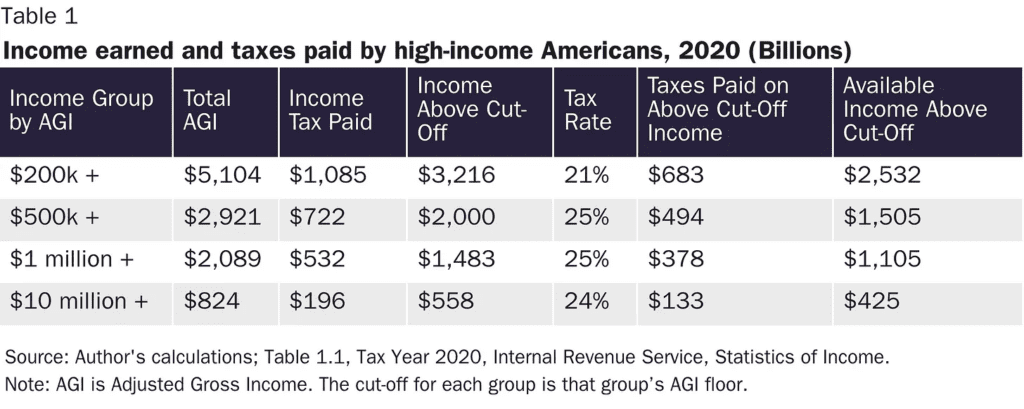
Adam Michel
There is simply not enough income at the top of the distribution to cover federal deficits.
Despite the headlines, the President’s 2024 Budget demonstrates how challenging it is to raise significant new tax revenue from a small minority of wealthy taxpayers. The budget raises about $1.8 trillion from non‐corporate taxpayers over ten years. Yet, following all the rhetoric about the rich not paying their fair share, it should be striking that across more than twenty new and expanded taxes, the administration’s plan does not even raise enough revenue from wealthy taxpayers to cover new spending proposed in Biden’s budget, let alone the projected $20 trillion deficit over the next ten years.
So, what’s going on? By promising the American people he would only raise taxes on people earning over $400,000, President Biden has made his budget math next to impossible. There is simply not enough income at the top of the distribution to cover the projected federal budget deficit, let alone a significant expansion in federal spending over the next decade.
What’s left to tax?
Using IRS data, we can illustrate the difficulty of raising a lot more revenue from a narrow segment of the population.
In 2020, the IRS reported that there were 164 million individual tax returns filed, with $12.6 trillion in Adjusted Gross Income (AGI). AGI includes wages, capital gains, and personal business income, in addition to other forms of income and adjustments for things like student loan interest and retirement contributions. This IRS data can show an upper bound on how much revenue could be extracted from the highest‐income taxpayers.
The IRS reports statistics by different income groups, separating taxpayers into buckets with AGIs of $200,000, $500,000, $1 million, and $10 million, among others. Table 1 shows four income groups and information from 2020 on how much total income was earned and taxes paid by each group.

For example, $2.9 trillion in total AGI was reported by taxpayers earning over $500,000, and they paid a total of $722 billion in federal income taxes, leaving them with about $2.2 trillion after‐tax income. There were 1.8 million tax returns above $500,000 or about one percent of all returns.
In the most extreme case of the federal government taxing all income over $500,000 at a 100 percent tax rate—confiscating every dollar earned past this point—not all of the $2.2 trillion is available to tax. The graduated income tax system is such that raising the top tax rate only increases taxes on the income in that tax bracket and above. Essentially, everyone’s income below the maximum rate is taxed the same. If Congress wants to raise taxes only on people earning over $500,000, the system of progressive rates effectively exempts the first $500,000 earned from additional taxes.
The IRS data show that for the $500,000 and above group, there is $2 trillion in taxable income above the $500,000 threshold. These high‐income taxpayers pay an average income tax rate of 25 percent, so they already paid roughly $500 billion in taxes on their above‐threshold income. Thus, only about $1.5 trillion remains after taxes (and is available for additional taxes), across all taxpayers earning more than $500,000.
If Congress confiscated every dollar earned by individuals and businesses past their first $500,000, it would still be about $200 billion short of covering the cost of next year’s projected $1.7 trillion deficit—unrealistically assuming no behavioral or other economic effects from taxing 100 percent of earnings.
Table 1 shows how the math of taxing the rich gets even more challenging the more income Congress exempts, showing figures for only raising taxes on people earning over $1 million or $10 million. Lowering the income threshold to $200,000 can expand income available for Congress to tax, but it is still not a realistic way to raise significant additional revenue. Common sense and economic incentives tell us that Congress cannot raise income tax rates anywhere close to 100 percent and still bring in any new revenue. Therefore, even a substantial fraction of the available income earned above $200,000 would not cover currently projected deficits.
Where’s the rest of the money going to come from?
Political rhetoric about raising taxes on the rich primarily serves as a distraction from the United States’ fiscal reality. If spending is not constrained, large and growing deficits will remain even after taxes are raised on corporations and the wealthy. The only way to significantly increase revenue is by raising taxes on a broader swath of middle‐income Americans.
Talking points like those President Biden routinely uses about the rich not paying their fair share in taxes have historically provided political cover to raise taxes on other segments of the population. Tax historian Joseph Thorndike explains how high marginal income tax rates in the New Deal era were used “to help justify regressive consumption taxes on alcohol and tobacco, which supplied anywhere from a third to half of federal revenue during the early 1930s.” Again, in the 1940s, Thorndike explains that high marginal tax rates of 90 plus percent (even though few people paid these rates) were used to provide political cover for a “dramatic downward expansion of the income tax.” Narrow taxes on the rich are leveraged into mass taxes on everyone.
As I’ve written elsewhere, every other large modern welfare state funds its higher levels of government spending with high taxes on a broad swath of the population. This is not because politicians in those countries do not want to tax the rich; it is because there is not enough money at the top of the income distribution to fund their desired spending levels.
It is often reported as irresponsible or implausible to suggest reducing federal spending as the key mechanism to stabilize the budget. However, it is accepted at face value that we can raise more than $2 trillion in additional annual revenue from the highest‐income one percent of American taxpayers. “Tax the rich” is not a serious budget proposal, and it should be treated as irresponsible and implausible.








